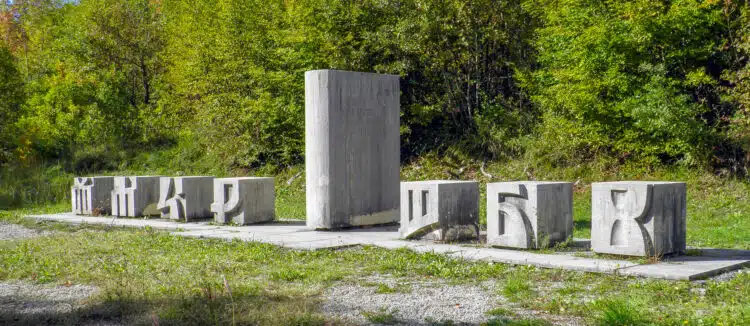What is it about the letters As, Buky, Wede, Glagoli, Dobro and Jest`? Well they have one thing in common: they are part of the so-called Glagionic script alphabet of Cyril of Salonika from the 9th century. Croatia vacationers can follow the oldest Slavic script for example on the Glagolitic Path in Baška on Krk or on the Glagolitic Alley from Roč to Hum in Istria. Also in the Cathedral of Zagreb you will find: here is a stone tablet with a Glagolitic inscription..
Culturally and script history interested sports boaters on Croatia course can go on day trips on Krk or in Istria on a voyage of discovery to the roots of the Slavic script. Here as there, some of the historical evidence of the Glagolitic script – or Glagoliza – the oldest Slavic alphabet, which was further developed around 863 by the Byzantine monk Constantine of Salonika (Cyril) for the mission in Pannonia and Moravia.
Since the Greek alphabet was only suitable for the Slavic languages to a limited extent and Cyril wanted to emphasize the cultural independence of the Slavs, he conceived the Glagolitic script as a so-called spaced script; i.e., he based it on the Greek system (letters with phonetic and numeric functions), but created a formally independent, completely new alphabet.
In Croatia (Dalmatia and Istria) mainly the younger, angular Glagoliza occurs
In addition to Greek minuscules, Caucasian (especially Armenian or Georgian) and Semitic writing systems served him as sources. From the constructive archetype of the glagoliza first a round, then also an angular variant developed. While the round glagolitsa was more common in the Bulgarian-Macedonian-Serbian area, the younger, angular script was mainly found in Croatia (Dalmatia and Istria).

Since the 9th century, the Bulgarian Empire also developed the Cyrillic script. This completely displaced the Glagoliza there until the 12th century. In Serbia, the Glagoliza could hold on until the 13th century, before it was no longer used there. In Dalmatia, on the other hand, the script remained in use for the Catholic liturgy, and the clerics using it were called glagoljaši.
Even today, the Glagoliza is considered a national symbol in Croatia and is often used
Croatia vacationers can encounter evidence of the old letter script, for example, on the island of Krk and in the northwestern Croatian region of Istria; here, glagoliza persisted for a long time, for example, in the Croatian Catholic Church. For the national movement of Croats that emerged in the 19th century, it even became a sign of demarcation against the Latin West and the Orthodox East.
Even today, the Glagoliza is considered a national symbol in Croatia. Example: the national sides of the Croatian euro coins of 1 cent, 2 cents and 5 cents, valid since January 2023, show a ligature of the letters Ⱈ (H) and Ⱃ (R) according to the international country abbreviation HR for Croatia as per ISO-3166-1. In addition, nowadays you still encounter it – or again – in jewelry, as logos or as tattoos.
Crews on Croatia cruise can walk along the Glagolitic Path on Krk
Those who have moored their lines off the island of Krk can set out on the Glagolitic Path (Croatian: bašćanska staza glagoljice) in Baška. The tourist attraction consists of several stone monuments, which can be found in various places of Baška and its surroundings, representing letters from the Glagolitic alphabet. The path is intended to commemorate the cultural heritage of the city and the country, including the Baška tablet, which was found there and was depicted on the 100 kuna notes.

The trail begins with the letter Az (45°1’40” N and 14°40’37” E), a monument about seven meters tall, carved out of stone, showing the first letter of the Glagolitic alphabet. It is found just after a hill next to the welcome sign of Općina Baška (Baška Municipality). From here it is then about seven to eight kilometers to the city center, where the symbolic end can be found at the port.
The end of the path is marked by a compass rose with the Greek omega
The symbolic end of the path is a compass rose with a Greek omega (44°58’9″ N 14°45’41” E; the Glagolitic script does not contain a corresponding letter), located at the end of the seafront / pedestrian zone. For the Omega, the artists who created this structure came up with something special: they integrated the letter into a stone wind rose.
This is not only pretty to look at, it also has a practical use value: around the Omega are first perpetuated on a square stone plate four letters for the four cardinal points: Z for Zapad (west), S for Sever (north), I for Istok (east), and Ю for Юgo (south; Glagolica, like the Cyrillic script, knows a ligature for the sound “Ju”).
On the wind rose the eight prevailing wind directions are represented – in Glagolitic
And: inscribed on the square of stone is a circle on which, among other things, the eight wind directions can be read for those who know writing, written as: Tramuntana, Bura, Levant, Jugo, Oštro, Lebić, Pulenat and Maestral. Next to the resulting wind rose is conveniently built a kind of stage, from which the stone tablet can be easily viewed and photographed from above.
Other Glagolitic letters can be found for instance at the entrance to Jurandvor (L; 44°59’0″ N; 14°37’36” E), at the connection between the Az and the beach (letters Ž and E – directly at a freshwater spring on the right side of the road(, followed by a stone with the two letters Đ and K on the left just before a narrow road bridge. Finally, on the main square of Draga Bašćanska, the sixth letter is J, and the W is next to the town sign of Batolomaj.

Here, the glagolitic path includes not only the letters themselves; sporadically, it also includes other works of art that play with glagolitic letters or texts. For example, if you hike up to the hill with the church of St. Ivan (Sveti Ivan), you can rest on a stone bench about halfway up and be surprised: the bench has a Glagolitic text on it.
Another project of this kind is the so-called Glagolitic Avenue in Istria
Another project of this kind is the so-called Glagolitic Avenue (Aleja glagoljaša in Croatian) in northwestern Croatia (Istria). It runs for six kilometers from Roč to Hum. Along the route, monuments commemorate eleven important stages in the historical development of the oldest Slavic script Glagoliza.

Realized in 1976 on the initiative of the Istrian cultural event Čakavski sabor according to the concept of writers Zvane Črnja (1920-1991) and Josip Bratulić (b. 1939); the stone sculptures were then created in subsequent years by sculptor Želimir Janeš (1916-1996).
The stations of the Glagolitic Avenue include the Column of the Čakavian People’s Assembly (Stup Čakavskog sabora), a two-meter high stone column in the shape of the Glagolitic letter S and the Table of Cyril and Methodius (Stol Ćirila i Metoda), a round three-legged table inscribed in Latin, Cyrillic, and Glagolitic script are carved the words STOL KIRILA I METODIJA, also the seat of Kliment of Ohrid (Katedra klimenta ohridskog), a cathedra with eight stone blocks acting as seats, arranged in a circle, which are supposed to symbolize the first Slavic school.
The Wall of Croatian Protestants and Heretics is a dry stone wall typical of the country with the Glagolitic letter S
Other stops on the historical avenue include the Glagolitic Lapidarium and the gorge of the Croatian Lucidar (Klanac hrvatskog Lucidara) in the village of Brnobići, the lookout point of Gregory of Nin (Vidikovac Grgura Ninskog, a stone block in the shape of a book), the rise of the Istrian Code (Uspon istarskog razvoda, represented by the Glagolitic letter L carved into a stone gate), and the Wall of Croatian Protestants and Heretics (Zid hrvatskih protestanata i heretika), a Not just nice to look at: The Gromačas, dry-stone walls in Croatia, are worth a stop with a recess in which the Glagolitic letter S in the shape of an hourglass has been embedded.

The town gate of Hum (Humska vrata), a two-winged gate studded with copper, is decorated with twelve medallions, each representing a month in the life of the house and yard. Tourists should pass through this gate only with good intentions: on the two door knockers there are Glagolitic inscriptions welcoming visitors to the city, but also threatening anyone who wants to enter with bad intentions.
You can also find it in other places in Croatia, such as the Zagreb Cathedral, where there is a stone tablet with a beautiful and well-preserved Glagolitic inscription.













